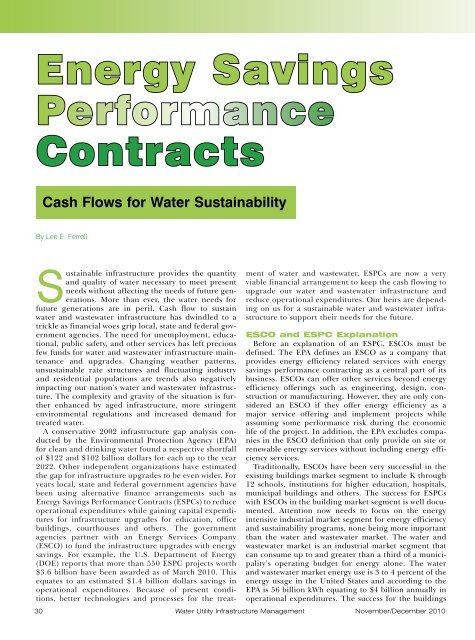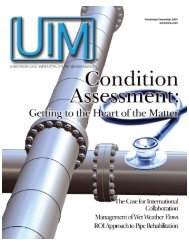Download - Water Utility Infrastructure Management
Download - Water Utility Infrastructure Management
Download - Water Utility Infrastructure Management
You also want an ePaper? Increase the reach of your titles
YUMPU automatically turns print PDFs into web optimized ePapers that Google loves.
Energy SavingsPerformanceContractsCash Flows for <strong>Water</strong> SustainabilityBy Lee E. FerrellSustainable infrastructure provides the quantityand quality of water necessary to meet presentneeds without affecting the needs of future generations.More than ever, the water needs forfuture generations are in peril. Cash flow to sustainwater and wastewater infrastructure has dwindled to atrickle as financial woes grip local, state and federal governmentagencies. The need for unemployment, educational,public safety, and other services has left preciousfew funds for water and wastewater infrastructure maintenanceand upgrades. Changing weather patterns,unsustainable rate structures and fluctuating industryand residential populations are trends also negativelyimpacting our nation’s water and wastewater infrastructure.The complexity and gravity of the situation is furtherenhanced by aged infrastructure, more stringentenvironmental regulations and increased demand fortreated water.A conservative 2002 infrastructure gap analysis conductedby the Environmental Protection Agency (EPA)for clean and drinking water found a respective shortfallof $122 and $102 billion dollars for each up to the year2022. Other independent organizations have estimatedthe gap for infrastructure upgrades to be even wider. Foryears local, state and federal government agencies havebeen using alternative finance arrangements such asEnergy Savings Performance Contracts (ESPCs) to reduceoperational expenditures while gaining capital expendituresfor infrastructure upgrades for education, officebuildings, courthouses and others. The governmentagencies partner with an Energy Services Company(ESCO) to fund the infrastructure upgrades with energysavings. For example, the U.S. Department of Energy(DOE) reports that more than 550 ESPC projects worth$3.6 billion have been awarded as of March 2010. Thisequates to an estimated $1.4 billion dollars savings inoperational expenditures. Because of present conditions,better technologies and processes for the treatmentof water and wastewater, ESPCs are now a veryviable financial arrangement to keep the cash flowing toupgrade our water and wastewater infrastructure andreduce operational expenditures. Our heirs are dependingon us for a sustainable water and wastewater infrastructureto support their needs for the future.ESCO and ESPC ExplanationBefore an explanation of an ESPC, ESCOs must bedefined. The EPA defines an ESCO as a company thatprovides energy efficiency related services with energysavings performance contracting as a central part of itsbusiness. ESCOs can offer other services beyond energyefficiency offerings such as engineering, design, constructionor manufacturing. However, they are only consideredan ESCO if they offer energy efficiency as amajor service offering and implement projects whileassuming some performance risk during the economiclife of the project. In addition, the EPA excludes companiesin the ESCO definition that only provide on site orrenewable energy services without including energy efficiencyservices.Traditionally, ESCOs have been very successful in theexisting buildings market segment to include K through12 schools, institutions for higher education, hospitals,municipal buildings and others. The success for ESPCswith ESCOs in the building market segment is well documented.Attention now needs to focus on the energyintensive industrial market segment for energy efficiencyand sustainability programs, none being more importantthan the water and wastewater market. The water andwastewater market is an industrial market segment thatcan consume up to and greater than a third of a municipality’soperating budget for energy alone. The waterand wastewater market energy use is 3 to 4 percent of theenergy usage in the United States and according to theEPA is 56 billion kWh equating to $4 billion annually inoperational expenditures. The success for the buildings30 <strong>Water</strong> <strong>Utility</strong> <strong>Infrastructure</strong> <strong>Management</strong>November/December 2010








